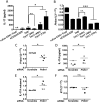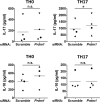Continuous time Bayesian networks identify Prdm1 as a negative regulator of TH17 cell differentiation in humans
- PMID: 26976045
- PMCID: PMC4791550
- DOI: 10.1038/srep23128
Continuous time Bayesian networks identify Prdm1 as a negative regulator of TH17 cell differentiation in humans
Abstract
T helper 17 (TH17) cells represent a pivotal adaptive cell subset involved in multiple immune disorders in mammalian species. Deciphering the molecular interactions regulating TH17 cell differentiation is particularly critical for novel drug target discovery designed to control maladaptive inflammatory conditions. Using continuous time Bayesian networks over a time-course gene expression dataset, we inferred the global regulatory network controlling TH17 differentiation. From the network, we identified the Prdm1 gene encoding the B lymphocyte-induced maturation protein 1 as a crucial negative regulator of human TH17 cell differentiation. The results have been validated by perturbing Prdm1 expression on freshly isolated CD4(+) naïve T cells: reduction of Prdm1 expression leads to augmentation of IL-17 release. These data unravel a possible novel target to control TH17 polarization in inflammatory disorders. Furthermore, this study represents the first in vitro validation of continuous time Bayesian networks as gene network reconstruction method and as hypothesis generation tool for wet-lab biological experiments.
Figures




References
-
- Korn T., Bettelli E., Oukka M. & Kuchroo V. K. IL-17 and Th17 Cells. Ann. Rev. Immunol. 27, 485–517 (2009). - PubMed
Publication types
MeSH terms
Substances
LinkOut - more resources
Full Text Sources
Other Literature Sources
Research Materials
Miscellaneous

